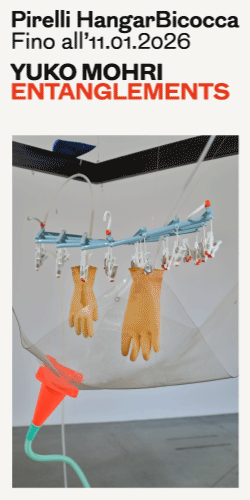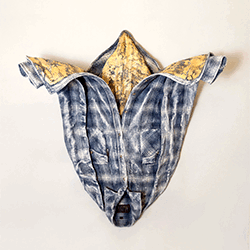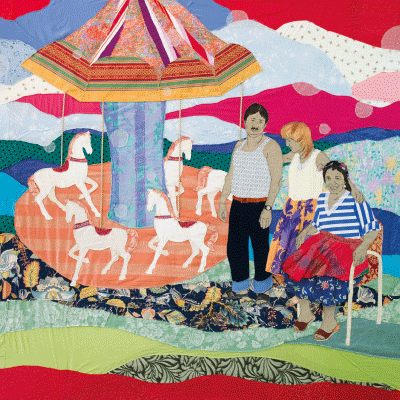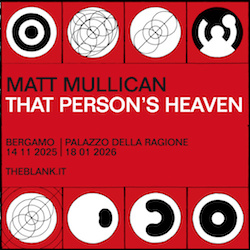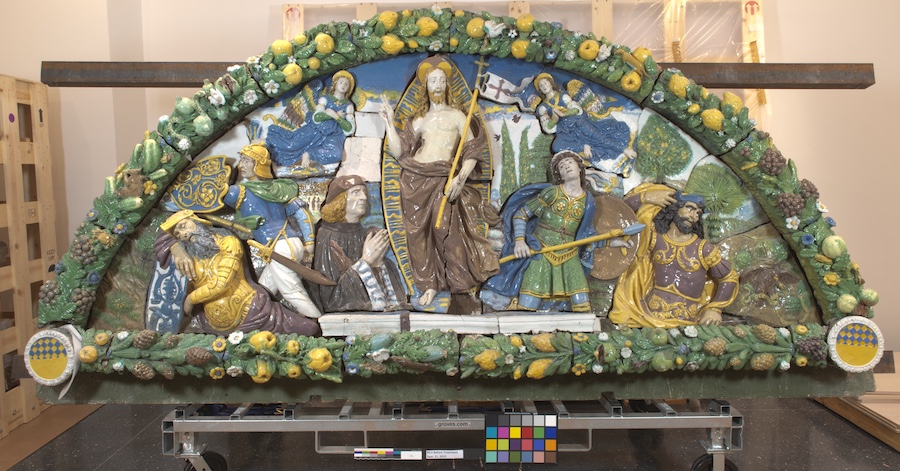
English text below
Inaugura il 9 novembre l’articolato progetto che vede coinvolto Stefano Arienti a confronto con il capolavoro di Giovanni Della Robbia. Nella recente intervista che abbiamo pubblicato l’artista è entrato nel merito di molte scelte che ha compiuto per la realizzazione di due interventi: al Museo Nazionale del Bargello con la mostra “Da Brooklyn al Bargello: Giovanni della Robbia, la lunetta Antinori e Stefano Arienti”; presso la cantina Antinori nel Chianti Classico con la nuova installazione site-specific “Altorilievo”.
Grazie a Ilaria Bonacossa, direttrice di Antinori Art Project e curatrice della mostra di Arienti, riusciamo a capire la sintonia e la bravura dell’artista nel rielaborare e restituirci un’opera legata al passato, ma con spunti e narrazioni nuovi e imprevedibili.
Segue l’intervista con Ilaria Bonacossa —
ATP: Iniziamo proprio dalle basi del progetto che da un paio d’anni segui per Antinori Art Project: la scelta degli artisti. In occasione dell’eccezionale presentazione della lunetta raffigurante La resurrezione di Cristo realizzata agli inizi del XVI secolo da Giovanni Della Robbia, perché la scelta di invitare Stefano Arienti a confrontarsi con questa importante opera?
Ilaria Bonacossa: Questa volta scegliere l’artista non è stato semplice, ne abbiamo discusso a lungo anche con Alessia Antinori. Era chiaro che servisse un artista affermato e che avesse una conoscenza della storia dell’arte. Inizialmente, dato che la lunetta, come quasi tutta la produzione dei Della Robbia, (una grande dinastia di artisti) in terra cotta invetriata, avevamo pensato ad artisti contemporanei che lavorassero la ceramica o la terracotta, ma ci siamo resi conto che il riferimento era troppo letterale e avrebbe rischiato di portare a delle reinterpretazioni parossistiche o ironiche. Ho capito che serviva un artista che avesse una certa dimestichezza nel maneggiare ‘immagini’ e in particolare opere storiche riappropriandosene e trasformandole in un codice linguistico contemporaneo. Quando Stefano Arienti ha accettato l’invito mi sono resa conto che nessuno ha la sua capacità in maniera così minimale di trasformare le immagini, rendendole ‘pop’ ma non per questo privandole della loro aurea, anzi al contrario spingendoci attraverso i suoi interventi a guardare le opere in maniera più intima e personale.

ATP: L’artista ha articolato il suo intervento in due progetti distinti, uno al Bargello, in una sala attigua a quella della lunetta, l’altro alla cantina Antinori nel Chianti Classico. Mi introduci la mostra “Da Brooklyn al Bargello: Giovanni della Robbia, la lunetta Antinori e Stefano Arienti”?
IB: La mostra nasce da una doppia volontà: da una parte riportare in Italia la Lunetta Antinori come viene chiamata dagli storici dell’arte dopo un importante restauro svolto dal team del Brooklyn Museum e sostenuto dalla famiglia Antinori; dall’altra l’idea di far rileggere a un artista contemporaneo un’opera storica sacra. La mostra al museo del Bargello si articola in due sale nella prima un’importante tela di John Singer Sargent dialogherà con la lunetta i cui tratti proto manieristi e i colori brillanti rendono veramente unica. Nella sala adiacente Stefano Arienti presenta “Scena Fissa” un tableaux vivants in cui i singoli personaggi e dettagli della lunetta originale sono tracciati in oro e bronzo su teli antipolvere bianchi da cantiere che occupano la sala evocando un presepe bidimensionale o le sinopie di un affresco mai finito.
I disegni di Arienti semplificano le figure, eliminando dettagli decorativi e lasciando solo i tratti che le rendono distinguibili. Questi teli appesi perpendicolarmente occupano la sala creando una sorta di scenografia teatrale in cui il pubblico si muove entrando in diretto dialogo con i singoli personaggi.
ATP: In merito all’intervento “Altorilievo”, che entrerà a far parte della collezione della famiglia Antinori, come ha sviluppato quest’opera, sempre in relazione alla lunetta di Giovanni Della Robbia?
IB: La lunetta originale è composta di 46 parte, legate ciascuna ad un personaggio principale ma che a volte riproducono più di un dettaglio. Dopo il restauro, in cui queste parti sono state separate e consolidate, la scelta dei conservatori è stata di non stuccare le giunture (come era sicuramente stato fatto da Giovanni della Robbia) ma di lasciare la struttura evidente. Stefano Arienti prima di cominciare a lavorare a quest’opera composta da due lavori separati nati in stretto dialogo, è andato al Brooklyn Museum per vedere l’originale dal vivo. Le pose teatrali e questa struttura che rendono la lunetta simile a un puzzle in tre dimensioni hanno colpito l’artista che a Bargino ha preso i 46 elementi della lunetta originale e le ha ricreate come altorilievi monocromatici tracciando in bronzo le figure. Le singole parti diventano qui elementi di una nuova narrazione nata del montaggio delle figure e dei dettagli della lunetta originale in cui l’evento la resurrezione di Cristo sembra essere dar vita a un nuovo svolgimento narrativo.
ATP: Stefano Arienti, nella sua lunga carriera, si è sempre avvalso di ‘immagini’ prelevate dalla storia dell’arte. L’artista compie, in questi suoi prelevamenti, una sorta di azione ‘ready made’: recupera un’immagine e ne elabora – e spesso modifica – la forma e il significato. Come si è confrontato l’artista con un’opera così importante come “La resurrezione di Cristo”?
IB: Credo che in questo caso Stefano Arienti sia partito dal disegno come forma di catalogazione e di conoscenza dell’originale, i successivi disegni offrivano poi una nuova lettura narrativa delle figure della lunetta in cui il Cristo e i committenti assumono pose quasi teatrali. Nella sua appropriazione non vi è però una volontà di parodia, al contrario la ripetizione di figure e schemi narrativi spingono il pubblico a scoprire i dettagli dell’originale, guardando la Lunetta Antinori in maniera nuova.

Giovanni Della Robbia’s Masterpiece reinterpreted by Stefano Arienti.
Bargello National Museum, Florence
Antinori nel Chianti Classico, Bargino
November 9th, 2017 – April 8th, 2018
Interview with Ilaria Bonacossa, the curator —
ATP: Let’s start from the fundamentals of the project that you have been working on for a couple of years, for Antinori Art Project: the selection of the artists. On the occasion of the important presentation of the lunette depicting The Resurrection of Christ made in the early 16th century by Giovanni Della Robbia, why did you choose Stefano Arienti to interact with this important work?
IB: This time, it wasn’t easy to choose the artist: I discussed this at length with Alessia Antinori, amongst others. It was obvious that we needed an artist of consolidated fame, someone with an extensive knowledge of art history. Considering that the lunette, like most works by the Della Robbia family (a great dynasty of artists) is in glazed terracotta, we were initially thinking of contemporary artists who work with ceramics or terracotta, but we realized that this was too literal a reference and we risked obtaining dramatic or ironic reinterpretations. I understood that the artist who fitted the situation would be familiar with working on ‘images’ and more specifically historical works, re-examining them and transforming them into a contemporary linguistic language. When Stefano Arienti accepted the invitation, I realized that he is unique for his skill in transforming images in such a minimalist manner, giving them a ‘pop’ appearance but without losing their essence, and on the contrary, encouraging observers to look at the works in a more intimate and personal way by means of his intervention.
ATP: The artist subdivided his work into two separate projects, one at the Bargello, in a hall adjacent to that where the lunette was on show, and the other at the Antinori Winery in the Chianti Classico district. Could you give us an introduction to the exhibition “From Brooklyn to the Bargello: Giovanni della Robbia, the Antinori Lunette and Stefano Arienti”?
IB: The exhibition is the result of a dual intention: on one hand, the chance of bringing the Antinori Lunette, as it is called by art historians, back to Italy after the important restoration performed by the team at the Brooklyn Museum, with support from the Antinori family; and on the other, the idea of asking a contemporary artist to reinterpret a historic religious work. The exhibition at the Bargello Museum is in two halls: in the first, an important canvas by John Singer Sargent will be placed in relation with the lunette, whose proto-mannerist features and bright colours make it absolutely unique. In the adjacent hall. Stefano Arienti presents Scena Fissa, a tableau vivant in which the individual personalities and details from the original lunette are rendered in gold and bronze on dust-proof site canvases that fill the hall, evoking a two-dimensional nativity scene, or the preparatory drawings for an unfinished fresco.
Arienti’s drawings simplify the figures, eliminating all decorative details and leaving just the lines that make them recognizable. These vertically-hung canvases take up the hall and create a sort of theatrical stage set within which observers come face to face with the individual figures.
ATP: With regard to the work “Altorilievo”, which will become part of the Antinori family collection, how was this work developed, in relation to the lunette by Giovanni Della Robbia?
IB: The original lunette consists of 46 parts, each linked to a main subject figure, but that sometimes depict more than one detail. After the restoration, in which these parts were separated and consolidated, the curators decided not to fill the joints with plaster (as Giovanni della Robbia certainly would have done) but rather to leave the structure clearly visible. Before starting to work on this piece, consisting of two separate works that nonetheless develop a close interaction, Stefano Arienti went to the Brooklyn Museum to see the original first-hand. The artist was fascinated by the theatrical poses, and the structure that makes the lunette similar to a three-dimensional puzzle, and at Bargino he took the 46 elements of the original lunette and reworked them in the form of monochromatic high-reliefs, using bronze to outline the figures. In this case the individual parts become elements of a new narrative deriving from the assembly of the figures and the details of the original lunette, in which the event, the resurrection of Christ, seems to have given rise to a new narrative depiction.
ATP: In his long career, Stefano Arienti has always used ‘images’ taken from the history of art. In these borrowed images, the artist performs a sort of ‘ready made’ operation, recovering an image, and working on it – often changing it – in terms of shape and meaning. How did the artist relate to such an important work as “The Resurrection of Christ”?
IB: I think that in this instance, Stefano Arienti started from the drawing as a way of gaining knowledge and cataloguing the original. The successive drawing then provided a new narrative interpretation of the lunette’s figures, in which Christ and the commissioning patrons are given almost theatrical poses. However, in his use of the images, there is no desire for parody. On the contrary, the repetition of figures and narrative schemes encourages observers to discover the details of the original, looking at the Antinori Lunette in a new way.


